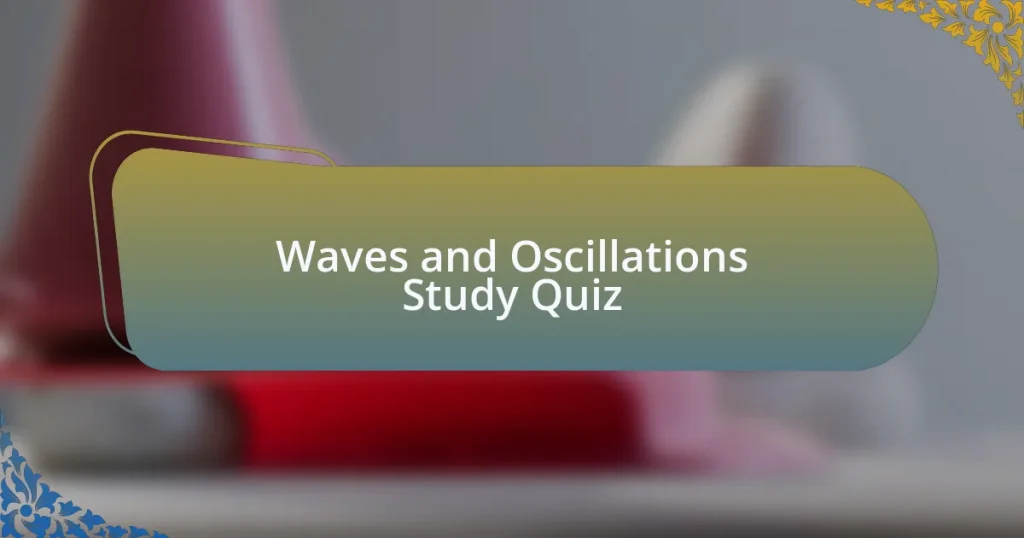Start of Quantum Mechanics Fundamentals Quiz
1. What is the primary postulate of Quantum Mechanics?
- The primary postulate of Quantum Mechanics is that all particles are massive at all times.
- The primary postulate of Quantum Mechanics is that the wave function contains all the information about the system.
- The primary postulate of Quantum Mechanics is that energy is continuous in all systems.
- The primary postulate of Quantum Mechanics is that particles have definite positions.
2. What is the Heisenberg Uncertainty Principle?
- The Heisenberg Uncertainty Principle states that the position of a particle can be known exactly if its velocity is known.
- The Heisenberg Uncertainty Principle states that energy and time cannot be precisely measured simultaneously.
- The Heisenberg Uncertainty Principle states that two particles can occupy the same space at the same time.
- The Heisenberg Uncertainty Principle states that it is impossible to know both the exact position and momentum of a particle at the same time.
3. What is Schrödinger`s Equation?
- Schrödinger`s Equation states that energy is quantized and always continuous.
- Schrödinger`s Equation describes the position of particles in classical mechanics.
- Schrödinger`s Equation predicts the exact path of a particle in motion.
- Schrödinger`s Equation is a mathematical equation that describes the time-evolution of a quantum system.
4. What is wave-particle duality?
- Wave-particle duality states that light can only travel in straight lines.
- Wave-particle duality claims that particles cannot interfere with each other.
- Wave-particle duality is the principle that no two particles can occupy the same space.
- Wave-particle duality is the idea that particles can behave as both waves and particles.
5. What is the significance of the Planck constant in Quantum Mechanics?
- The Planck constant is the speed of light in a vacuum.
- The Planck constant is the charge of an electron.
- The Planck constant determines the mass of a particle.
- The Planck constant is a fundamental constant that relates the energy of a photon to its frequency.
6. What is quantum entanglement?
- Quantum entanglement is the correlation between the states of entangled particles, regardless of the distance between them.
- Quantum entanglement is the idea that particles can exist in multiple states at once.
- Quantum entanglement is the phenomenon where particles are destroyed upon measurement.
- Quantum entanglement is the principle that all particles are identical in nature.
7. What is the superposition principle?
- The superposition principle indicates that energy levels cannot overlap.
- The superposition principle states that forces acting on an object are additive.
- The superposition principle states that a quantum system can exist in multiple states simultaneously.
- The superposition principle asserts that particles cannot exist in more than one location.
8. What is the Pauli Exclusion Principle?
- The Pauli Exclusion Principle states that no two electrons in an atom can have the same set of quantum numbers.
- The Pauli Exclusion Principle allows two electrons to have the same spin.
- The Pauli Exclusion Principle states that electrons can share quantum numbers if they are in different atoms.
- The Pauli Exclusion Principle only applies to neutrons in an atom.
9. What is the significance of the wave function`s square in Quantum Mechanics?
- The square of the wave function indicates the energy levels of a quantum system.
- The wave function describes the velocity of a particle over time.
- The wave function`s square determines the temperature of a system.
- The square of the wave function gives the probability density of finding a particle in a particular state.
10. What is the double-slit experiment?
- The double-slit experiment demonstrates the wave-like behavior of particles, such as electrons, by showing an interference pattern on a screen.
- The double-slit experiment measures the charge of an electron in a vacuum.
- The double-slit experiment analyzes the speed of light using a prism.
- The double-slit experiment determines the mass of a photon through energy loss.
11. How does the fringe spacing in the double-slit experiment change with particle type?
- The fringe spacing is constant for all particles.
- The fringe spacing can vary based on the particle mass.
- The fringe spacing decreases with lighter particles only.
- The fringe spacing increases for faster particles only.
12. How does the bandgap energy of a quantum dot depend on its size?
- The bandgap energy is unrelated to the size of the quantum dot.
- The bandgap energy of a semiconductor quantum dot increases as the size decreases.
- The bandgap energy remains constant regardless of the size.
- The bandgap energy decreases as the size decreases.
13. How does the absorption peak of a color center depend on the lattice constant?
- The absorption peak wavelength does not depend on the lattice constant at all.
- The absorption peak wavelength is linearly proportional to the lattice constant (∝ d).
- The absorption peak wavelength of a color center depends directly on the square of the lattice constant (∝ d^2).
- The absorption peak wavelength is inversely proportional to the lattice constant (∝ 1/d).
14. What is the probability of finding an electron in a specific state in an infinite potential well?
- Approximately 0.2500
- Approximately 0.1000
- Approximately 0.3000
- Approximately 0.0500
15. What is the normalization condition for a wave function?
- The normalization condition for a wave function states that the derivative of the wave function over all space equals zero.
- The normalization condition for a wave function states that the wave function must be continuous at all points.
- The normalization condition for a wave function states that the integral of the absolute square of the wave function over all space equals one.
- The normalization condition for a wave function states that the wave function must equal one at every point in space.
16. What does the quantum number n represent in the quantum mechanical model?
- The orbital angular momentum quantum number.
- The principal quantum number n.
- The spin quantum number.
- The magnetic quantum number.
17. What approximation method is used for solving perturbation problems?
- Finite Element Method
- Variational Method
- Perturbation Theory
- Taylor Expansion
18. Who proposed the wave-particle duality concept?
- Louis de Broglie
- Albert Einstein
- Niels Bohr
- Max Planck
19. What is the role of the wave function in predicting particle behavior?
- The wave function only describes the physical properties of particles without predicting behaviors.
- The wave function serves only as a mathematical tool without any physical significance.
- The wave function indicates the average position of a particle but does not give probabilities.
- The wave function provides a complete description of a quantum system`s state and predicts the probabilities of finding particles in various configurations.
20. What experimental evidence supports the wave nature of particles?
- The double-slit experiment
- Newton`s cradle
- The photoelectric effect
- Rutherford`s gold foil experiment
21. What does it mean for a system to be in a superposition state?
- A quantum system can exist in multiple states simultaneously.
- A quantum system can only exist in one state at a time.
- A quantum system can transition between states only when observed.
- A quantum system can never change its state.
22. How does the energy of a system relate to its quantum states?
- The energy of a system is quantized, correlating to discrete quantum states.
- The energy of a system is continuous and varies smoothly with time.
- The energy of a system is independent of its quantum states and can change at will.
- The energy of a system is always zero in all quantum states.
23. What is a potential barrier in quantum mechanics?
- A potential barrier is a temperature threshold for superconductivity.
- A potential barrier is a point where particles cease to exist.
- A potential barrier is a region in space where the potential energy is higher than the energy of the particle.
- A potential barrier is a force acting on charged particles only.
24. How does quantum mechanics differ from classical mechanics in regards to energy?
- Classical mechanics represents energy as a series of steps, while quantum mechanics portrays it as infinitely variable.
- Classical mechanics describes discrete energy levels, while quantum mechanics describes continuous energy.
- Classical mechanics treats energy as non-existent, while quantum mechanics acknowledges it only in particles.
- Classical mechanics describes energy as a fixed quantity, while quantum mechanics describes it as a random outcome.
25. What role does the Planck constant play in the quantum realm?
- The Planck constant is used to calculate gravitational forces.
- The Planck constant describes the speed of light in a vacuum.
- The Planck constant measures the mass of an electron.
- The Planck constant relates the energy of a photon to its frequency.
26. What is meant by a `quantum state`?
- A quantum state is a physical object that can be touched.
- A quantum state is a mathematical description of a system in quantum mechanics.
- A quantum state is a chemical reaction between particles.
- A quantum state is a classical position of a particle in space.
27. How is quantum tunneling significant in physics?
- The impossibility of a particle moving through barriers.
- The certainty of a particle`s location after crossing a barrier.
- The probability of a particle penetrating a potential barrier.
- The reflection of all particles at a barrier.
28. What are eigenfunctions in quantum mechanics?
- Eigenfunctions are continuous functions that represent physical particles in motion.
- Eigenfunctions are special functions that correspond to certain measurable values (eigenvalues) in quantum mechanics.
- Eigenfunctions are random functions that have no specific relation to quantum states.
- Eigenfunctions are the classical trajectories of particles in a potential field.
29. What does the normalization of a wave function achieve?
- It defines the shape of the wave.
- It ensures the total probability is one.
- It makes the wave function complex.
- It increases the energy of the particle.
30. What is the significance of boundary conditions in quantum mechanics?
- They define the gravitational potential of the system.
- They determine the permissible energy states of a quantum system.
- They dictate the mass of the particles in the system.
- They establish the temperature of the quantum system.
Quiz Completed Successfully!
Congratulations on completing the quiz on Quantum Mechanics Fundamentals! We hope you found this challenge both engaging and educational. Understanding quantum mechanics is crucial for a solid foundation in physics. Through this quiz, you likely explored key concepts such as wave-particle duality, superposition, and quantum entanglement. Each question may have sparked new ideas and deepened your appreciation of the quantum world.
Whether you found the quiz challenging or straightforward, each answer you pondered helped reinforce your knowledge. It’s beneficial to reflect on how these principles apply to real-world phenomena. Recognizing the implications of quantum mechanics can transform your perspective on technology, such as quantum computing and telecommunications. The quest for knowledge is always rewarding, and you’ve taken a great step forward.
We invite you to expand your understanding even further. Check out the next section on this page dedicated to Quantum Mechanics Fundamentals. Here, you’ll find more in-depth information, resources, and insights that will enhance your preparation for any physics test. Delve deeper into the fascinating world of quantum mechanics, and continue your journey to mastering this vital area of study!
Quantum Mechanics Fundamentals
Introduction to Quantum Mechanics
Quantum mechanics is the branch of physics that deals with the behavior of matter and energy at the smallest scales. It fundamentally changes our understanding of the universe compared to classical physics. It introduces concepts such as wave-particle duality, superposition, and entanglement. These principles describe how particles like electrons and photons behave in ways that defy traditional logic. Quantum mechanics lays the foundation for various modern technologies, including semiconductors and quantum computing.
Key Principles of Quantum Mechanics
The key principles of quantum mechanics include the uncertainty principle, wave-particle duality, and quantization of energy. The uncertainty principle, formulated by Werner Heisenberg, states that certain pairs of physical properties cannot be simultaneously measured with arbitrary precision. Wave-particle duality suggests that particles exhibit properties of both waves and particles, depending on the experiment. Quantization indicates that energy levels in atoms are discrete rather than continuous. These principles challenge classic notions of determinism in physics.
Mathematical Framework of Quantum Mechanics
The mathematical framework of quantum mechanics primarily relies on linear algebra and complex numbers. State functions, represented by wave functions, describe the probabilities of a system’s properties. The Schrödinger equation is a fundamental equation that predicts how these wave functions evolve over time. Operators acting on these wave functions provide measurable quantities like position and momentum. This mathematical approach allows precise predictions about physical systems at the quantum level.
Quantum Mechanics in Test Preparation
Preparing for tests in quantum mechanics involves understanding key concepts, problem-solving techniques, and familiarization with mathematical tools. Students should grasp fundamental theories and their implications. Practice problems, such as calculating wave functions or using the Schrödinger equation, help reinforce these concepts. Reviewing past exam questions can also provide insight into common topics and question formats, aiding effective preparation for assessments.
Applications of Quantum Mechanics
Quantum mechanics has numerous applications, ranging from technology to theoretical physics. It is essential for the development of lasers, MRI machines, and transistors. In theoretical physics, quantum mechanics is foundational for quantum field theory and understanding fundamental forces. These applications highlight its vital role in both practical technologies and advanced scientific research, illustrating its pervasive influence in modern life.
What is Quantum Mechanics?
Quantum mechanics is a fundamental theory in physics that describes the physical properties of nature at the scale of atoms and subatomic particles. It provides a mathematical framework for understanding phenomena such as wave-particle duality, quantization of energy levels, and the uncertainty principle. This theory has been confirmed through various experiments, including the double-slit experiment, which demonstrates the wave-like behavior of particles.
How does Quantum Mechanics differ from Classical Physics?
Quantum mechanics differs from classical physics primarily in its treatment of energy and matter. Classical physics operates under deterministic laws, where future states can be predicted with certainty. In contrast, quantum mechanics incorporates probabilistic outcomes, meaning that the exact state of a particle cannot be determined until it is measured. This fundamental shift is highlighted by phenomena like superposition and entanglement, which have no analog in classical physics.
Where is Quantum Mechanics applied in real-world technology?
Quantum mechanics is applied in various real-world technologies, including semiconductors, lasers, and MRI machines. For example, transistors, the building blocks of modern electronics, rely on quantum tunneling. Additionally, quantum information science, such as quantum computing and quantum cryptography, are emerging fields that leverage quantum principles for advanced computational capabilities and security.
When did Quantum Mechanics originate?
Quantum mechanics originated in the early 20th century, with key developments occurring between 1900 and 1930. Max Planck’s introduction of quantization in 1900 marked the beginning of quantum theory. This was followed by pivotal contributions from physicists like Albert Einstein, Niels Bohr, and Werner Heisenberg, solidifying the framework of quantum mechanics by the 1930s.
Who were the key contributors to the development of Quantum Mechanics?
Key contributors to the development of quantum mechanics include Max Planck, who proposed quantization of energy; Albert Einstein, known for his explanation of the photoelectric effect; Niels Bohr, who developed the Bohr model of the atom; and Werner Heisenberg, who formulated the uncertainty principle. Their collective work laid the foundation for modern quantum theory.













